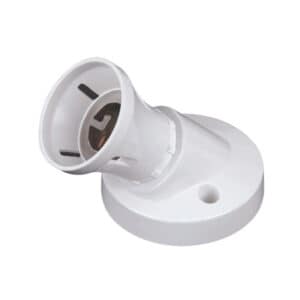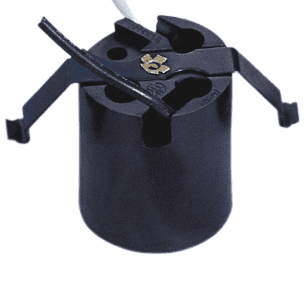What is a Bakelite lamp holder?
A Bakelite lamp holder is an electrical component that is used to hold and support a light bulb. It is made of Bakelite, which was one of the earliest plastics developed and was popular in the early 20th century for its electrical insulation properties and durability. Bakelite lamp holders are typically found in vintage or antique lighting fixtures and are favored for their classic, retro look.
They come in various shapes and sizes to fit different types of light bulbs, and are often used in conjunction with a socket and a switch to complete an electrical circuit. The Bakelite material provides electrical insulation and heat resistance, making the lamp holder safe for use in electrical wiring systems.
Bakelite lamp holders are still used today, especially in restoration and renovation projects where a vintage look is desired.

What is the history of Bakelite lamp holders?
Bakelite, the material used to make the lamp holders, was developed by Belgian-born chemist Leo Baekeland in 1907. Bakelite was the first synthetic plastic, and it quickly became popular for its durability and electrical insulation properties.
In the early days of electrical lighting, lamp holders were typically made of metal and porcelain, and they often lacked the durability and insulation needed for safe and effective operation. With the advent of Bakelite, manufacturers were able to produce lamp holders that were safer, more durable, and less expensive. Bakelite lamp holders became popular in the 1920s and 1930s, and they were used in a variety of lighting fixtures, from table lamps to ceiling fixtures.
Over the years, Bakelite lamp holders have evolved and improved, but they have remained popular for their classic look and their role in the history of lighting. Today, Bakelite lamp holders are often used in restoration and renovation projects, as well as in new construction projects where a vintage look is desired. They are also used in specialized applications where their electrical insulation and heat resistance properties are valued. The history of Bakelite lamp holders is a testament to the ingenuity and creativity of early inventors and manufacturers, and to the lasting impact of their work on the lighting industry.

What is a Plastic lamp holder?
A plastic lamp holder is an electrical component that is used to hold and support a light bulb. As the name suggests, it is made of plastic, which is a versatile and durable material that is commonly used in the lighting industry. Plastic lamp holders come in various shapes and sizes to fit different types of light bulbs, and they are used in a variety of lighting fixtures, from table lamps to ceiling fixtures.
Plastic lamp holders are favored for their low cost, lightweight, and ease of use, and they are often used in conjunction with a socket and a switch to complete an electrical circuit. The plastic material provides electrical insulation and heat resistance, making the lamp holder safe for use in electrical wiring systems. Plastic lamp holders are available in a range of colors, styles, and finishes, allowing designers and consumers to choose a lamp holder that best fits their needs and aesthetic preferences.
Overall, plastic lamp holders are a popular and versatile choice for lighting fixtures and offer a cost-effective and durable option for holding and supporting light bulbs.

What is the history of plastic lamp holders?
The history of plastic lamp holders dates back to the mid-20th century, when the development of synthetic plastics revolutionized the manufacturing industry. Prior to the advent of plastic, lamp holders were typically made of metal and porcelain, which were durable but often lacked the electrical insulation properties needed for safe and effective operation. With the development of synthetic plastics, manufacturers were able to produce lamp holders that were safer, more durable, and less expensive.
Plastic lamp holders became popular in the 1950s and 1960s, as advances in plastic manufacturing techniques made it possible to produce high-quality plastic components in large quantities. Plastic lamp holders were used in a variety of lighting fixtures, from table lamps to ceiling fixtures, and their low cost and ease of use made them a popular choice for consumer and commercial lighting applications.
Over the years, plastic lamp holders have evolved and improved, and they are now used in a wide range of lighting fixtures and applications. The development of plastic lamp holders marked a major milestone in the history of lighting, as it made it possible to produce safe, durable, and cost-effective lamp holders that could be used in a variety of applications.
Today, plastic lamp holders continue to be a popular and versatile choice for lighting fixtures, and they are an important part of the lighting industry’s history and development.
What is the difference between a Bakelite and a plastic lamp holder?
Bakelite and plastic lamp holders are similar in that they are both used to hold and support a light bulb in a lighting fixture.
However, there are some important differences between the two materials that set them apart.
Bakelite lamp holders are made of Bakelite, which was one of the earliest plastics developed and was popular in the early 20th century for its electrical insulation properties and durability. Bakelite is a type of phenolic plastic, which is a class of plastics that are characterized by their electrical insulation and heat resistance. Bakelite lamp holders are often used in vintage or antique lighting fixtures, and they are favored for their classic, retro look.

Plastic lamp holders, on the other hand, are typically made of a variety of different synthetic plastics, and they are used in a wide range of lighting fixtures and applications. Plastic lamp holders are favored for their low cost, lightweight, and ease of use, and they are often used in conjunction with a socket and a switch to complete an electrical circuit. The plastic material provides electrical insulation and heat resistance, making the lamp holder safe for use in electrical wiring systems.
Based on my experience, I think the main difference between Bakelite and plastic lamp holders is the material from which they are made. Bakelite lamp holders are made of Bakelite, a type of phenolic plastic, and are favored for their classic look and electrical insulation properties. Plastic lamp holders are made of a variety of synthetic plastics, and are favored for their low cost, lightweight, and ease of use.
Both materials have their advantages and disadvantages, and the choice between a Bakelite or plastic lamp holder will depend on the specific needs and preferences of the user.
